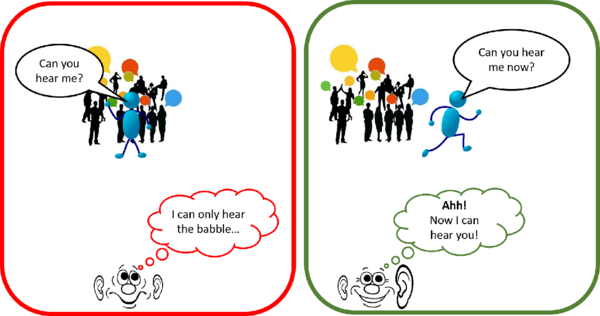Binaural unmasking of dynamic sound sources in rooms
Humans have two ears for a reason. They enable us to localize sound sources from different directions, but also to better detect and perceive sounds in noise. The advantage of better detection with two ears is called binaural unmasking. Since almost all sounds in our daily life change dynamically over time – may it be because they move or we turn our head – our research interest lies in better understanding how binaural unmasking takes place with dynamic sounds. Our experiments show that for moving sound sources, binaural unmasking is reduced compared to static situations. Even for slow velocities (e.g. at a speed of a walking pedestrian in 2 meters distance), binaural unmasking is about 2.5 dB less than that for a static source (Kolotzek & Seeber, ICA 2019). This difference remains constant also for higher velocities.
In rooms, sound reflections change the ear signals over time, which can hinder or improve detection of a sound. We found improvements even if reflections arrive as late as 150 ms after the direct sound, if the noise and the sound of interest are coming from the same direction (Kolotzek, Aublin & Seeber, DAGA 2021). We are also working on auditory models to predict detection thresholds of a dynamic sound source in noise (see auditory modeling and Kolotzek, Aublin & Seeber; arXiv 2021).

Team members involved
Norbert F. Bischof, M.Sc.
Funding
Funded by TUM and associated with the Deutsche Forschungsgemeinschaft (DFG, German Research Foundation) – Projektnummer 352015383 – SFB 1330 C5. The rtSOFE system was funded by BMBF 01 GQ 1004B.
Selected publications
Kolotzek, N.; Aublin, P.G.; Seeber, B.U.: The effect of early and late reflections on binaural unmasking. Fortschritte der Akustik - DAGA '21, 2021 [mehr…] [Volltext (mediaTUM)]
Kolotzek, N.; Aublin, P.G.; Seeber, B.U.: Fast processing explains the effect of sound reflection on binaural unmasking. Professur für Audio-Signalverarbeitung, 2021, [mehr…]
Kolotzek, N.; Seeber, B.U.: Spatial unmasking of circular moving sound sources in the free field. Proc. 23rd International Congress on Acoustics, integrating 4th EAA Euroregio 2019, 2019, 7640-7645 [mehr…] [Volltext (mediaTUM)]